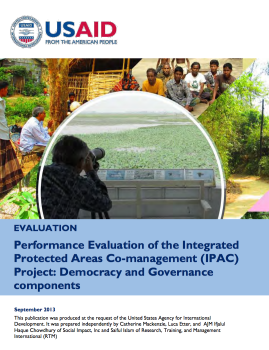Performance Evaluation of the Integrated Protected Areas Co-management Project: Democracy and Governance Components
Integrated Protected Areas Co-management (IPAC) Project was a five-year (2008–13), $12.78 million project in the environment sector of Bangladesh, building directly on two USAID-funded predecessor projects: Nishorgo Support Project (NSP; 2000–08) and Managing Aquatic Systems through Community Husbandry (MACH; 1998–2008). Together, these projects responded to a suite of governance problems underlying the critical state of Bangladesh‘s environment by focusing on protected areas (PAs) and promoting improved biodiversity conservation through ―co-management (CM), a multi-stakeholder participatory approach designed to improve conservation outcomes by giving local communities a central role in the conservation and management of natural resources.
IPAC‘s objectives were to help the Government of Bangladesh‘s (GoB) Forest Department (FD), Department of Fisheries (DoF), Department of Environment (DoE), and local stakeholders develop a coherent national strategy for Protected Area Co-management (PACM). This strategy sought to integrate wetlands, forests, and ecologically critical areas into a single system, while further strengthening the legislative and financial foundations of the system, building institutional capacity at the local and central levels, and expanding the system of comanaged protected areas on the ground.


